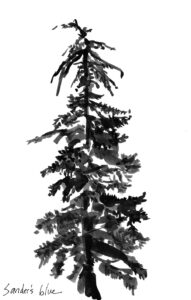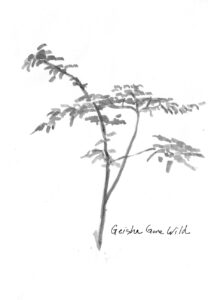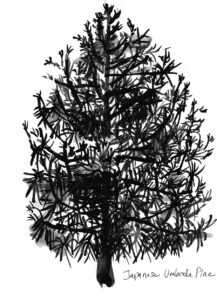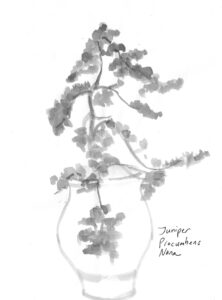Story and drawings by Abraham Storer
Keri Thomas and David Smile’s garden comes as a surprise to a visitor arriving on Oak Ridge Road in Eastham, not far from Cooks Brook. The neighborhood is a collection of 1960s cottages built on half-acre lots. Some houses have been expanded and renovated over the years, but this remains a modest, traditional Cape Cod back road, where most gardens are edged with hydrangeas and brightened by daylilies at this time of year. But the Thomas-Smile garden stands out for its expansive range of color, textures, and shapes, filled with more than 70 varieties of Japanese maples, 20 varieties of hydrangeas, and unique evergreens.
“We’re plant collectors,” says Thomas. The couple’s collection not only fills up their garden but has expanded into pots on their porch and even into their neighbors’ yards.
The couple bought their house here in 2013 but it took a few years for them to start gardening. Only gradually did the garden begin to take shape as they renovated the original 560-square-foot house, adding to it in a style informed by midcentury modernist design. This summer, for the first time, the garden is one of the stops on the Eastham Garden Tour, which is part of the Cape Cod Hydrangea Festival.
Q: What was this place like when you started?
Keri Thomas: It was a completely overgrown disaster. It was the yard where all the neighbors dumped their yard debris. We did multiple burn piles before we could even navigate through the whole area.
Q: Did you work from plans to create the garden?
KT: I remember Dave saying to me, “We’re not going to be planting things up here.” The house was such a huge project and Dave did a lot of the renovating himself. We had no grand design.
David Smile: We did a little here and a little there. It just started coming together and kept escalating.
Q: How did you get interested in Japanese maples?
KT: We had an existing established one on our Wakefield property.
DS: The red one that you see everywhere.
KT: Which we loved. And then we got married in 2009 and friends gave us a ‘Sango kaku’.
DS: It looks like a green tree in the summer but in the winter the bark looks red. There are so many different types of Japanese maples, about 2,000 varieties, and they’re all completely different. They have different leaf colors, different shapes, different colors in spring versus summer versus fall. You can just keep learning and learning about them.
Q: What was the first Japanese maple you bought for this garden?

KT: It was an ‘Autumn Moon’ maple, a gold tree that we got at The Farm [the Orleans nursery owned by brother-and-sister team Sean Richardson and Sassy Roche]. It was beautiful and teeny. It’s yellow-orange throughout the year.
DS: A lot of the garden centers carry just the very basic ones. Sean Richardson would have a couple of oddballs.
KT: He’s been getting more and more unique ones over the years. And once you go down the rabbit hole of Japanese maples and Japanese maple societies, you learn about all of the super-secret garden centers in the Northeast, some in people’s back yards.
Q: How does your garden change through the year?
DS: When you look around now in any direction you see reds and yellows. During the spring, the color is very dramatic, then it tends to fade a little in the summer. By late summer, the trees start to change colors. Having our garden change color every two or three weeks was a goal of mine.
KT: In the winter, the trees’ branching structure is like artwork. The winter color on the ‘Sango kaku’ looks like somebody spray-painted it bright red. It’s outstanding. We got two new ‘Bihou’ maples because in the winter they have yellow and mango-colored branches. We planted them in spaces where we want that winter interest.
Q: How would you describe your gardening style?
KT: We’re more into foliage than flowers. I don’t want to worry about things coming into bloom and out of bloom. I want it to look pretty all the time. We do a lot of shade gardening and focus on color and texture.
DS: We’re influenced by Japanese garden design, which includes unique conifers, Japanese maples, and water features. As our tastes matured, we took out some plants. We don’t have space for a lot of new things anymore, so we have to make decisions about taking plants out. We often give them to our neighbors.

Q: What do you enjoy most about gardening?
KT: Just this morning I was on my hands and knees, and I was edging grass, which is my least favorite garden chore. My face was in a swath of sage, and I was just thinking to myself, you know, some people go to the spa to make themselves feel better. This is my spa. I am thoroughly enjoying this sensory experience. My hands are in dirt, I’m sweating, I’m breathing sage, and I’m loving every minute of it.
Q: How would you advise someone starting a garden?
KT: I would start with the major evergreen structure in the garden.
DS: The structure doesn’t really show much until six to nine years into it. Then everything starts to get scale. When you start, everything’s about the same size.
Q: Tell me about your evergreens.
KT: We wanted a privacy barrier from the neighboring summer rentals, but we didn’t want to put up a big fence. We started with Leyland cypresses and cryptomerias. We planted a whole line of rhododendrons. We then went from the structural evergreens to things like the ‘Fukai’, a variegated Japanese pine and a dwarf hinoki cypress called ‘Moonshine’ — they’ve got these little white inflorescences. I love variegated things, anything with leaf interest or needle interest. We have a new evergreen in a pot called ‘Angel falls’. It’s a weeping white pine. We saw a mature one in someone’s yard in Lenox and thought we had to have it. We took a picture of it, looked online, and hunted it down. We sort of get a little obsessed.
Q: How do your plants do in the Cape Cod climate? 
DS: For a lot of the conifers and Japanese maples, the climate here is similar in some respects to the West Coast or Oregon, with long autumns, and the humidity is similar, too, which is favorable for the Japanese maples.
KT: Dave and I don’t like to fight our plants. So, we don’t generally grow things that struggle. If there’s something that needs to be sprayed or something that needs to be babied, we’re done with it.
Q: How do you choose what goes into your garden?
A plant has to earn its real estate in our garden by having at least three seasons of interest. You will not see a simple lilac or forsythia in our garden because they bloom for two and a half weeks and then they’re just either a dead stick or they’re a green shrub the rest of the year.
Cape Cod Hydrangea Festival
The event: Eastham Garden Tour
The time: Tuesday, July 9, 10 a.m. to 4 p.m.
The place: Five locations listed at capecodchamber.org
The cost: $5 per garden, cash only at each garden, benefits the Eastham Public Library



